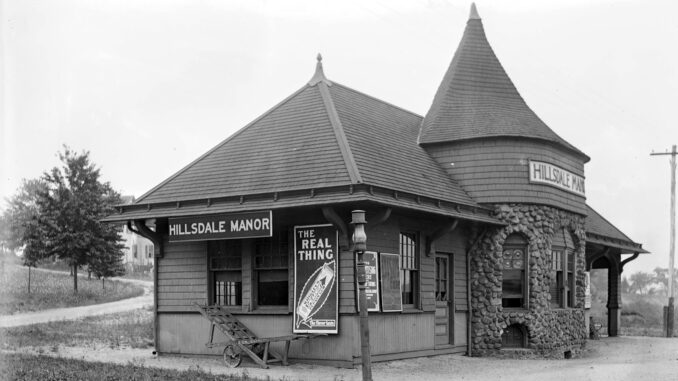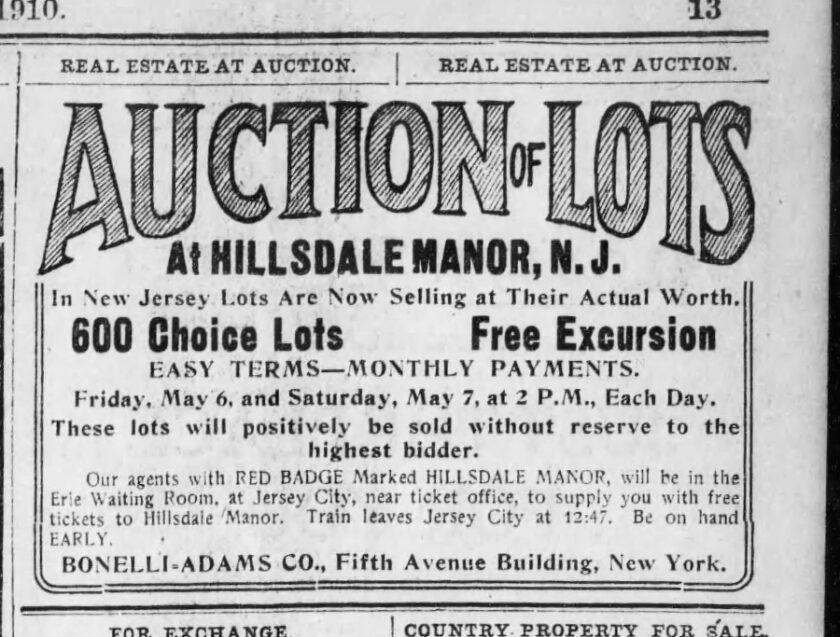
HILLSDALE, N.J.—Hillsdale’s railroad station at Broadway and Hillsdale Avenue is a focal point of the community, an important piece of local history, and a landmark that even appears on the borough seal. But did you know — at one time Hillsdale had a second train station.
The second railroad depot, built in 1893, served a part of town called Hillsdale Manor. Constructed of wood and fieldstone, with a rounded entrance and black turret, it stood along the tracks close to the intersection of Broadway and Parkview Avenue, in the area opposite ShopRite.
The Manor section of Hillsdale, at its peak from the 1890s to the 1910s, was a popular vacation resort for the wealthy from New York City. Separated from greater Hillsdale by untouched forest landscape, Hillsdale Manor had a distinct personality. It was a town within a town—an enclave with its own train station, stores, hotels and newspaper.
The Manor encompassed lands in northeastern Hillsdale, between Lincoln Avenue to the north, Knickerbocker and Piermont avenues to the south, Broadway to the west and St. Mary’s and Raymond streets to the east. Driving along these suburban roadways today, peppered among the mid-century homes one will find a number of older residences with fieldstone elements. These are relics of a construction style that was ubiquitous in the Manor.
The Hillsdale Manor Improvement Company, having acquired a large portion of the land in this section in 1891, had it surveyed and subdivided.
The Passaic Daily News wrote on Oct. 6, 1891, “A party of capitalists, most of whom are Brooklynites, have purchased a tract of land in Bergen County, N.J., a short distance north of Hillsdale village. This land, which comprises the hills in North Bergen County, with a valley on either side, is being laid out into building plots…This place is to be called Hillsdale Manor.”
To advertise their new development, the company issued a brochure giving all the descriptive particulars of this newly mapped region. They made it sound like a veritable paradise, as real estate ads are inclined to do.
“The finest suburb of New York is undoubtedly Hillsdale Manor. It is situated in the far-famed highlands of northern New Jersey, absolutely free from malaria, with an abundance of pure water and fine, bracing air,” the brochure read.

The marketing was aimed at New Yorkers, urging them to flee from the stifling city streets and settle in the little country village, whose convenient railroad stop would enable them to commute and have the best of both worlds. Buyers were offered a one-year commutation ticket for free as an added incentive.
“Many handsome residences are already built upon the property, and more are being erected by people of refinement and taste, who clearly recognize how much better it is to live in a roomy house, in a beautiful suburb, than a ‘hole in a wall’ in the crowded city,” the brochure added.
The company boldly claimed, “Hillsdale Manor is not a barren plain, a boggy swamp, a sandy desert, or a wilderness of rocks, but a high rolling plateau, finely wooded…The streams of the surrounding valleys abound with trout, pickerel, and other fish. The air is dry and bracing, free from the dampness and humidity which are so objectionable in New York and Brooklyn, and many country places. Mosquitoes are positively never seen on the property!”
Most of the people who purchased lots at Hillsdale Manor in the 1890s never ended up building homes there. Although the streets had been cut through as designed, most of them were unpaved and the woodland continued undisturbed for many years.
Some years after the 1890s promotion by the Hillsdale Manor Improvement Co., and when other owners were involved, another concerted effort was made by the Bonelli-Adams Co., of 200 Fifth Ave., New York City, to dispose of a large block of building plots in the development.
In May 1910, the company hosted a two-day auction of 600 lots. They offered free transportation to the sale from Jersey City and Hackensack via a special train, and a military band was hired for a parade.
Over $5,000 in prizes, including four upright pianos, were given away. The company sold 250 lots in the auction, although, once again, the majority were not developed. It wasn’t until the post-World War II population boom that the neighborhood became filled with houses.The Hillsdale Manor railroad station in 1910, on the east side of the tracks, south of Parkview Drive.
The station was in use for 50 years before it was torn down in the 1940s
